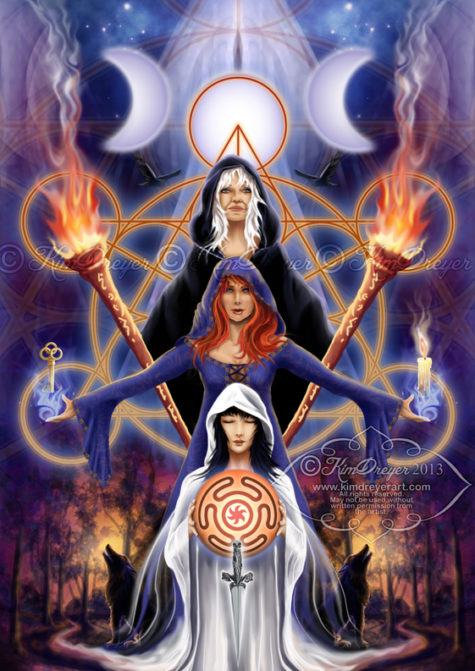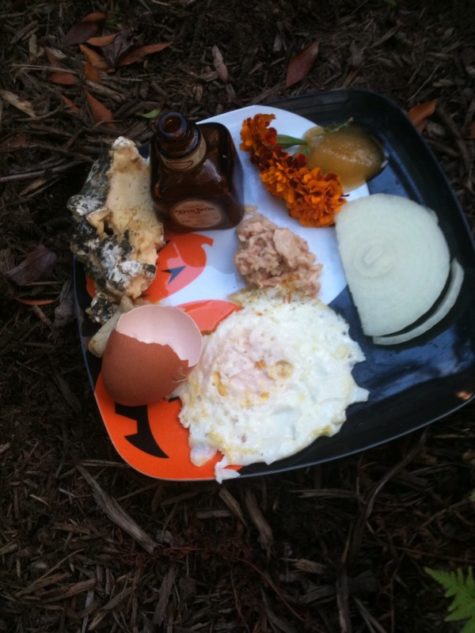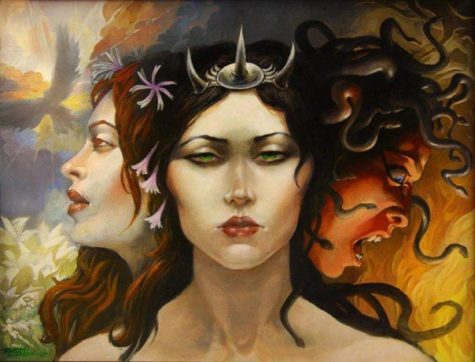Hecate
The new moon is sacred to the goddess Hekate, and these cakes are ideal for use in rituals honoring her, as well as for Hekate Suppers, or an offering to leave at a crossroads. Many of the ingredients are sacred to the Dark Goddess, additionally there are 3 x 3 ingredients, using the number three which is also sacred to Hekate.
- 1 1/2 cups flour
- 1/2 cup of soft butter
- 1/4 cup of honey
- 1/2 tsp baking soda
- 1/2 tsp salt
- 2 tbsp black poppy seeds
- 1 egg
- 1/2 tsp almond extract
- 1 tsp anise seeds
Directions:
(If possible use organic ingredients and free-range fertile eggs.) Sift the flour, salt and baking soda together. Cream the butter, honey and egg. Blend the two mixtures together and add the remaining ingredients. Shape into small thin crescent shapes. Place with space between the shapes to allow for spreading during baking on a cool, oiled baking tray.
Bake at 350 F for about 12 minutes or until lightly golden.
~Sue Bowman, Keys to the Crossroads
In Italy, August 13 is the Day of Hekate. Hekate is an exceptionally powerful spirit. She holds dominion over life, death, regeneration, and magic. She rules wisdom, choices, expiation, victory, vengeance, and travel. Hekate guards the frontier between life and death. She is an intermediary between the spirit world and that of humans. She is the witness to all crimes, especially those against women and children.
Here’s a Hekate Ritual from “Moon Magick” by D.J. Conway. While this ritual can be done on any day dedicated to this Queen of the Night, the Spirit World, and Witchcraft, I thought this might be something interesting for today:
You will need:
- a ritual dagger
- small cauldron
- a wand
- an apple
- a piece of black cloth
- a small bit of salt
- other ritual items you might choose to use.
Put the apple in the cauldron and cover the cauldron with the black cloth. Cast your circle. With the wand tap the cauldron five times and say:
Hekate, Wise one, I ask your blessings.
Lift the Veil for me that I may greet my spirit helpers,
Long-ago friends from other lives, and those who are new.
Let only those who wish me well enter within this sacred place.
Uncover the cauldron. Take out the apple, raise it in offering, and lay it on the altar.
Hekate, your Magick cauldron is the well of death and rebirth
An experience each of us under goes again and again.
Let there be no fear in me, for I know your gentleness,
Here is your secret symbol of life in death.
Cut the apple crosswise with the dagger. Contemplate the revealed pentagram in the core. Put the two halves of the apple back into the cauldron and cover them again with the black cloth.
Only the initiated may know your hidden Mysteries.
Only the true seekers may find the spiral way.
Only those who know your many secret faces
May find the Light that leads to the Inner Way.
Put a pinch of salt on your tongue:
I am mortal, yet immortal.
There is no end to life, only new beginnings.
I walk beside the Goddess in her many forms.
Therefore, I have nothing to fear.
Open my mind and heart and soul
To the Deep Mysteries of the Cauldron, O Hekate.
Do a meditation on seeking the Dark Moon goddess. Listen to her messages. Be aware of any new guides and teacher who may come through to help you.
The last day of each of the lunar months is the sacred day of the triple goddess of crossroads and the patroness of Witches, Hekate.
Hekate had many names and titles: Hecate Trevia, “of the three ways”; Hecate Phosphoros, “the light bringer”; Hecate Nykterian “of the night”; and Hecate Basileia, “Hecate Queen.” On this night of the waning Moon we have a perfect opportunity to work with this goddess and ask for her blessing to illuminate our darkest times, and grant us her protection.
Hecate, goddess of the crossroads, hear my cry,
Protect and guard me under your midnight sky.
Hecate Phosphoros “she who brings the light,”
Hecate Trevia bless me with your wisdom tonight.
Hekate’s ancient devotees held dinners in her honor, known as Hekate Suppers. Once upon a time, these dinners were consumed outside under the dark moon, ideally at a crossroads. One plate was reserved for Hekate; after her devotees dined, just before they departed, Hekate’s plate was laid down at the crossroads.
Foods associated with her were prepared. The entree was usually fish, especially red mullet. Devotees feasted and celebrated. Offerings and leftovers were placed outside the door or at a crossroads for Hekate and her hounds.
Even way back when, cynics scoffed that food placed outside was actually consumed by feral dogs and homeless people without realizing that this is Hekate’s intent: this is one way she accepts offerings. (The Church was still trying to eradicate this ritual as late as the eleventh century.)
A typical Hekate Supper menu includes eggs, fish roe, goat and sheep cheese, sprats, red mullet – a scavenger fish that was the subject of many taboos – garlic, mushrooms, and honey cake surrounded by blazing torches or cakes decorated with miniature imitation torches (candles). Other ideas include garlic, salmon, honey, and edible flowers.
Traditionally whatever is given to Hekate cannot be reclaimed. Thus, do not break out your priceless set of china; lay the meal on the ground or use a serving dish that will be incorporated into the offering. Once the offering is laid down, depart without looking back. Hekate determines who picks up the offering.
Smaller, private offerings may be left at a crossroads, too:
- Place offerings on a plate or flat stone and leave them at a crossroads after dark.
- Make your invocation and then walk away without looking back.
- Do not return for the plate, or any part of the offering, but consider it part of your gift.
Offerings can include the following:
- Eggs
- Garlic and honey (especially lavender honey)
- Croissants and crescent shaped breads and pastries
- Candles
- Incense
- Images of dogs, especially black dogs
- Actions on behalf of dogs
Encountering or hearing a dog is an indication that your petition has been heard.
Other nights sacred to Hekate:
- Friday the 13th – particularly if it falls in the month of August.
- November 16th is Hekate Night
- August 13th, in Italy, a festival is shared between Diana and Hekate
Sources:
- Invocation by Ellen Dugan
- The Powers That Be
For modern Wiccans and Neo-Pagans, Nov 16 is designated as Hekate Night, or the Night of the Crossroads, the day of the festival of Hecate Trivia, which is a day that honors Hecate as a goddess of crossroads.
Her feast day begins at sunset, and most often consists of a feast referred to as Hekate Supper, A meal to which Hekate is invited, and given her own plate of food, which is then left at a crossroads.
This practice, particularly associated with the sacred three-way crossroads of Hekate, is the depina Hekates, or Hekate Supper. It may be that these offerings were made to appease ghosts and keep them at the crossroads, avoiding trouble from them whilst traveling etc. Alternatively these offerings were described as being made to placate the goddess and ensure that she would look favorably upon those who made regular offerings.
- More about Hekate Suppers here: Night of Hekate Suppers
- Invocations and prayers to Hekate: Widdershins
- Spells and Magick: Book of Shadows
- About the Goddess: The Powers That Be
It has been suggested that the crossroads was sacred to Hekate due to her having been abandoned at a crossroads as a baby by her mother Pheraea, and then rescued and brought up by shepherds. This Thessalian tale comes from a scholiast to Lycophron’s 3rd century BCE play Alexandria, and was a late invention.
Aristophanes recorded that offerings to Hekate were made “on the eve of the new moon” which is when the first sliver of the new moon is visible, signifying a possible connection with Hekate as a lunar goddess, rising, like the moon, from the underworld on the night of the new moon.
There are also references to the offerings being made on the thirtieth day of the month, but keep in mind that this was calculated on the Greek calendars, it would vary from state to state as there was no uniformity in the calendar system being used.
It has further been suggested that the offerings made at the Hekate Suppers were a form of charity, and certainly the consumption of the food by the poor was noted by Aristophanes (5th century satirist):
“Ask Hekate whether it is better to be rich or starving; she will tell you that the rich send her a meal every month and that the poor make it disappear before it is even served.”
The 10th century Byzantine encyclopedia, the Suda, paraphrased this quote and added the following:
“From her one may learn whether it is better to be rich or to go hungry. For she says that those who have and who are wealthy should send her a dinner each month, but that the poor among mankind should snatch it before they put it down. For it was customary for the rich to offer loaves and other things to Hekate each month, and for the poor to take from them.”
Various sources mention different foods offered to Hekate at the suppers. These were:
- Magides – A type of loaf or cake
- Mainis – Sprat
- Skoroda – Garlic
- Tigle – Mullet
- Psammeta – Sacrificial cake somewhat like the psaista
- Oon – Eggs (raw)
- Tyros – Cheese
- Basunias – A type of cake
Another type of food offering which was left to Hekate on the eve of the full moon was the amphiphon, a type of cake. Amphiphon means “light-about,” an appropriate name for this flat cheesecake which was surrounded by small torches.
The supper, or leaving of offerings at the crossroads was one of the hardest practices for the Christian church to stamp out. Records indicate it was still taking place in the 11th century CE, and it may well have continued far longer.
About Hekate
She is the Triple Goddess, and most often associated with a three-way crossroad. She is Hecate the Maiden, Hecate the Mother, and Hecate the Crone. Although the dark of the moon is her traditional time, Hecate can be called upon during any moon phase, as She is the One and the Three.
She is the goddess of witchcraft, the night, the new moon, ghosts, necromancy and crossroads. Hekate had few public temples in the ancient world, however, small household shrines, which were erected to ward off evil and the malevolent powers of witchcraft, were quite common.
She is a Goddess like no other. A goddess who is not to be invoked lightly, or by those who are calling upon her frivolously. Some describe her as a Witch Goddess who rises up from the dark depths of the underworld, whilst others tell of a bright shining Goddess who holds her torches of illumination high, revealing the path through the mysteries, but only for those with the wisdom to follow her.
Some say that she is the Axis Mundi, the Chaldean World Soul and that she brings soul fire and light to humanity. Others tell of a powerful Goddess who is crowned with the coils of wild serpents and oak leaves, appearing with three heads, often with three bodies, sometimes in forms which are part-human and part-beast. We are told that she holds sway in many worlds, bearing the keys to the thresholds between, guarding and blessing those who make suitable offerings to her, but feared by those who let injustice come upon the world.
Hekate stands at the crossroads bearing the keys to the mysteries. In the ancient world she inspired poets and philosophers, witches, magicians and ordinary people, all of whom knew she could bestow blessings to improve their lot and protect them from the harsh denizens of the infernal realm. Today she continues to inspire and evoke awe in those who encounter her; for some in subtle ways, leading them in an elusive nameless manner with her symbols, for others in a more powerful and directly empowering way.
Sources:








